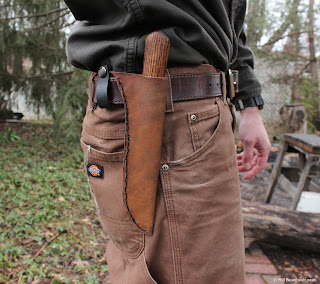Buy this knife here: https://www.etsy.com/listing/613348749/viking-scramasax-hand-forged-with-an-ash?ref=shop_home_active_2
Forged out of a coil spring on the last day of winter, I have come to call this one the "Equinox". The six-inch drop-point blade was forged from a coil spring into a scramasax style inspired by Norwegian archaeological finds. In an effort to keep the knife as historically accurate as possible, I used mainly hand tools such as files to shape the edge bevels and a draw knife to carve the handle. The sheath is hand-stitched leather, dyed with homemade birch oil and coated with a beeswax-based leather conditioner to give it some water-resistance.
The sheath is set up for a horizontal carry method, as in the Viking Age large knives like this would have been worn on the front of the belt. The belt loops are held in place with copper fittings in the style of some Swedish examples.
The handle is a beautiful ash wood, stained with linseed oil to bring the most out of the dark grain. It has a good feel in hand, with a slightly oval shape to it. Fairly light and well-balanced, the weight favors the blade to make it nimble in use and it would excel for hunting or camping chores. It would also serve well as a food or utility knife around the homestead.
This is a a one-of-a-kind knife, and while I may make another one similar, there will never one quite like this one.

















































